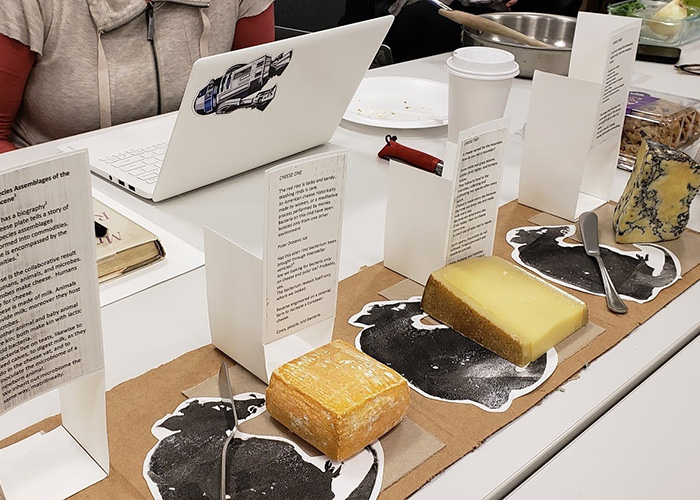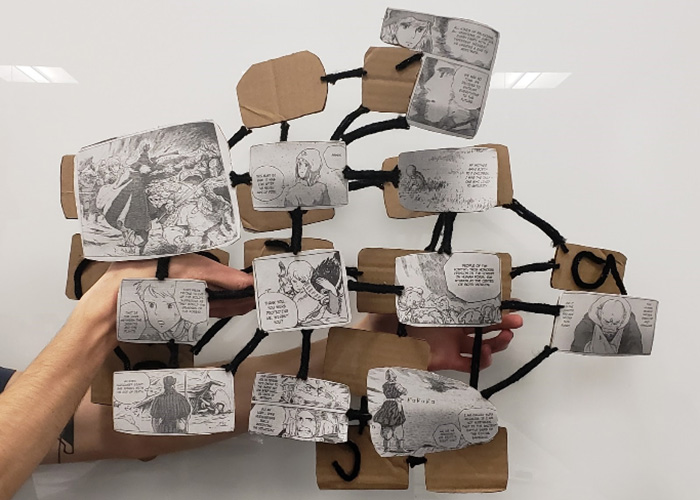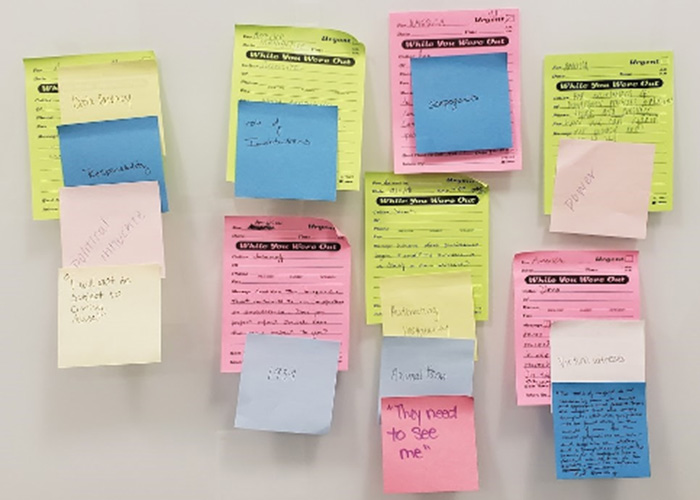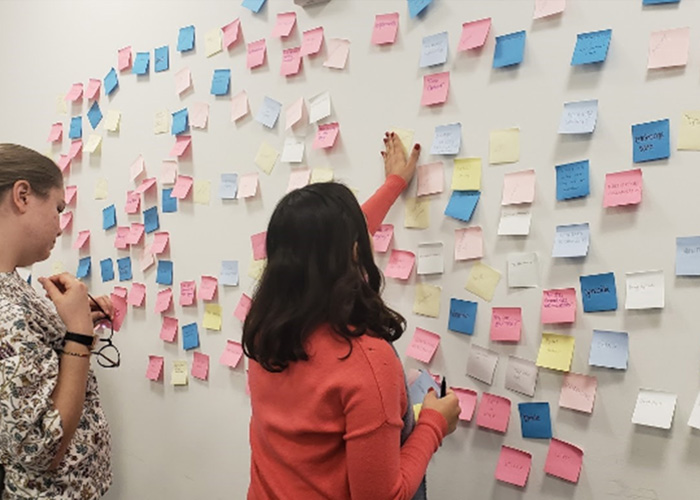Course Methodology: STS Theory Studio
By Ali Kenner, PhD
January 08, 2020
This article was originally published on Backchannels, a scholarly blog by the Society for Social Studies of Science. Alison Kenner, PhD, is an associate professor of politics and of science, technology and society.
I did not expect that students would use their potluck dish as part of their final project submission. We ate heptapod brownies, inspired by the extraterrestrial species in the movie “Arrival,” and learned about bacteria, mold, and transnational technoscience as we sampled artisan cheeses. These potluck offerings were science, technology and society theory models, in edible form — nourishment for finals week at Drexel University.
 STS master’s student Ann Campbell’s theory model, “Multispecies Assemblages of the Capitalocene.”
STS master’s student Ann Campbell’s theory model, “Multispecies Assemblages of the Capitalocene.”
STS Theory Studio is the final graded assignment in the Science, Technology and Society Theories course (SCTS 504) I teach, and makes up 25% of the course grade. It happens over a 10-14-day period, but the emphasis is on what happens in our seminar room over a space of about 6-8 hours: small and large group discussion; timed writing activities; concept mapping with paper and writing supplies; and collaborative theory making. The aim is to bring story, concept, and physical models of theory into conversation.
The Studio sequence roughly happens as follows:
Friday, Week 1: Students receive STS Theory Studio prompts
This class consists of movies or short stories, and writing and research activities that draw together material covered throughout the term.
Wednesday, Week 2: First, in-person Theory Studio (3.5 hours)
The first studio might include a writing activity, such as, “If you could be any STS theory, what would you be…?” There is also a discussion of the assigned film, followed by a mapping activity that employs quotes from the film and STS texts.
Wednesday, Week 3: Second, in-person Theory Studio (4 hours)
This class has consisted of, for example, enjoying potluck offerings and presentation of theory models, small group discussion and storytelling using “While You Were Out” notes (see below), followed by a broader course debrief on STS pedagogy and career futures — because these things should be explicitly talked about in all courses, in my opinion, and not just on the last day.
Friday, Week 3: Theory Studio portfolio is due
Students submit a written reflection, in any genre, accompanied by visuals and theory model (if not consumed during the Studio).
 Drafting time capsules.
Drafting time capsules.
Each time I have offered the course, the staging of the Studio, the materials, and the final products have been a bit different. One of the assignments required for last year’s Theory Studio was a theory model. As described above, several students used their potluck dish as their theory model. Other students modeled STS theory with art and craft supplies — cardboard, pipe cleaners, photographs, and paint — and by incorporating other objects, such as a basketball and an iPhone. Some students used standalone physical objects and/or consumer products to narrate their chosen theory.
 Double-sided theory model using sci-fi by STS master’s student Drex Drexler.
Double-sided theory model using sci-fi by STS master’s student Drex Drexler.
What does collaborative story building look like in an STS class? After watching “Arrival” in conversation with a written publication, students chose the second sci-fi piece on their own: one person read “Nausicaä of the Valley of the Wind,” a serialized comic; another watched “The Monsters are Due on Maple Street,” an episode from “The Twilight Zone;” “Mrs. Frisby and the Rats of NIMH” and episodes from “Futurama” were resurrected too; and of course, students watched various episodes from “Black Mirror.” In the end, we never made it to the Studio activity where we deployed this media. We simply ran out of time; this happens in Theory Studio, despite my own efforts to carefully time activities. This material did make it into students’ theory models, however, and also our story-building activity.
This year, we added in “While You Were Out” notes as part of our storytelling structure. On assigned spatial sections of the classroom wall, students left each other “While You Were Out” notes that continued a line of thought from the writing activity in week one or the presentation of theory models, or from the movie or a course reading. The notes also started conversations; students began responding to each other using this twilight technology, and even acted as notetakers for a character’s message.
 Using ‘While You Were Out’ notes (a twilight technology) to build stories.
Using ‘While You Were Out’ notes (a twilight technology) to build stories.
The idea for Theory Studio was inspired by my time working as a teaching assistant with Dean Nieusma, PhD, in Rensselaer Polytechnic Institute’s Program in Design, Innovation, and Society, and particularly the feeling of a studio and the kinds of engagement that are possible in that timespace. Keith Murphy and George Marcus’s ethnocharette (2013) project gave me ideas for Studio structure and activities, as well as outcomes.
But Theory Studio also responds to the context that I’m teaching in, a master’s program where we have a mix of students who have a variety of career trajectories: some going on to PhD programs and others on to industry, or in some cases, who are already working professionals. About a third of the students come from other degree programs, and are looking for STS tools — methods and concepts — to bring back to their home disciplines. It took me two years to realize that structuring assignments towards dissertation prep or a qualifying exam was not appropriate for the majority of our students. Our student community needed an evaluation structure that was open and flexible to their varied career trajectories, and relationships to STS.
 Sharing language from “Arrival,” as well as STS concepts.
Sharing language from “Arrival,” as well as STS concepts.
Theory Studio engages different sensory registers as we walk around the classroom space — often in patterned ways as we move between materials and ongoing conversations. We share food and listen to music. Some segments of the Studio are done in silence, but this is a not-unfamiliar soundscape in academia, recalling the quiz or exam. Theory Studio asks, what kinds sensory registers might we work and learn in?
While Theory Studio sounds like fun and games — and it is — it also requires the trust of students. How is Theory Studio graded? What does an assessment rubric look like for such an experiment? This two-week long activity is in many ways a performance. But it’s a performance that applies theory, presents and curates source material, interprets and creates materials, and is executed in collaboration.
I want to thank all the STS Theories students who have taken this course with me; it is an exercise in trust and communication laden with power and stakes. Theory Studio at root was inspired by our time together in class discussion and your work in course assignments. Thank you all for your work on this project, STS Theory Studio.
Texts Thought With
- Dumit, J. (2014). Writing the implosion: teaching the world one thing at a time. Cultural Anthropology, 29(2), 344-362.
- Fortun, K. (2009). “Figuring out ethnography.” Fieldwork isn’t what it used to be. Cornell University Press, Ithaca.
- Haraway, D. J. (2016). Staying with the trouble: Making kin in the Chthulucene. Duke University Press.
- hooks, b. (2014). Teaching to transgress. Routledge.
- Murphy, K. M., & Marcus, G. E. (2013). Epilogue: Ethnography and design, ethnography in design... ethnography by design. Design anthropology: Theory and practice, 251-68.
- Salter, C., Burri, R. V., & Dumit, J. (2017). Art, design, and performance. The handbook of science and technology studies, 139-67.